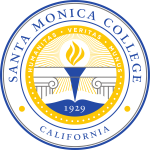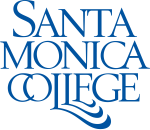Santa Monica Review
 |
|
|
Former names
|
Santa Monica Junior College (1929–1945) Santa Monica City College (1945–1970) |
|---|---|
| Motto |
|
|
Motto in English
|
|
| Type | Community college |
| Established | 1929 |
|
Academic affiliation
|
CCCS ACCJC |
| Budget | $574.1 million (2016–17) |
| President | Kathryn Jeffery |
|
Academic staff
|
2,023 |
| Students |
30,830 (Fall 2016) 11,315 full-time 19,515 part-time |
|
Other students
|
3,396 non-credit |
| Location |
Santa Monica, California, United States 34°01′00″N 118°28′15″W / 34.0168°N 118.4707°WCoordinates: 34°01′00″N 118°28′15″W / 34.0168°N 118.4707°W |
| Campus |
Urban 38 acres (15 ha) |
| Newspaper | The Corsair |
| Colors | Blue and white |
| Nickname | Corsairs |
| Mascot | Pico the Corsair |
| Website | smc |
 |
|
Santa Monica College (SMC) is a public two-year community college in Santa Monica, California, United States. Founded as a junior college in 1929, SMC enrolls over 30,000 students in more than 90 fields of study. Although initially serving primarily pre-college high school students, the College quickly expanded its enrollment to educate college-age students and non-traditional students with the primary intention to transfer to a four-year university. Today, two thirds of students at Santa Monica College are enrolled part-time. With over 2,000 employees, SMC is a major employer in the Greater Los Angeles Area and has a significant impact in the region's economy.
Occupying the entire Santa Monica Community College District, SMC is the only public institution of higher education in Santa Monica. The main campus, located on Pico Boulevard, is the college's largest location. The College operates five satellite campuses across Santa Monica.
SMC is the leader in California's 113 community college system in transfers to the University of California. Since 1929, SMC has provided job training, educational opportunities and cultural enrichment through its radio station KCRW (89.9 FM), the Broad Stage at the SMC Performing Arts Center and lifelong learning through distinctive programs such as its Emeritus College for older adults.
Santa Monica College opened in September 1929 as Santa Monica Junior College with 7 faculty members and 153 students in classes held on the second floor of Santa Monica High School. Attended primarily by high school students, it was originally part of the Santa Monica-Malibu Unified School District. Despite the ensuing Wall Street Crash of 1929 and Great Depression, the school's enrollment increased to 355 in 1930 and 600 in 1931. In 1932, the College moved to the vacant brick Garfield Elementary School building on Michigan Avenue. The building was declared unsafe following the 1933 Long Beach earthquake and classes moved to tents and bungalows on the Garfield site, which students nicknamed Splinterville.
...
Wikipedia
